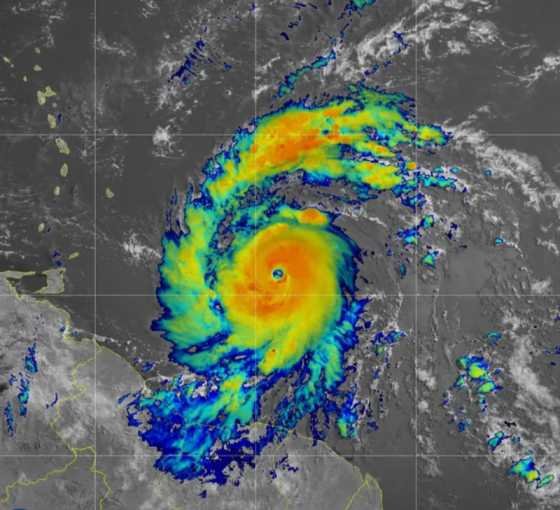As Hurricane Beryl Barrels Toward Caribbean Isles, It’s Already “Historic”. Hurricane Beryl is a formidable force as it barrels toward the southeastern Caribbean, evolving into a Category 3 hurricane. With its current path set to affect several islands, Beryl’s approach is being met with urgent preparations and widespread concern. This article delves into Beryl’s impact, historical context, and the measures being taken to mitigate its effects.
1. Understanding Hurricane Beryl’s Current Status
- As of early Monday, Hurricane Beryl was approximately 125 miles east-southeast of Grenada and 140 miles southeast of St. Vincent, moving west at 20 mph. With maximum sustained winds of 120 mph, Beryl’s compact nature sees hurricane-force winds extending 35 miles from its center. The U.S. National Hurricane Center in Miami has issued hurricane warnings for Barbados, St. Lucia, Grenada, Tobago, and St. Vincent and the Grenadines, emphasizing the life-threatening potential of this storm.
2. Historical Context of Hurricane Beryl
Previous Records and Milestones
- Beryl’s rapid intensification is noteworthy, having become a Category 3 hurricane in just 42 hours—a rare feat in Atlantic hurricane history. It further intensified to a Category 4 storm, setting a record as the earliest storm of this magnitude in the Atlantic. The previous record was held by Hurricane Dennis in July 2005.
Significance of Early June Activity
- Beryl’s formation and intensification are particularly unusual for this time of year. Typically, such powerful hurricanes form later in the season when ocean temperatures are higher. Record warm waters in the deep Atlantic, unusually high for early June, acted like fuel for Beryl’s development.
3. Impact on the Caribbean Nations
Areas Under Threat
- Beryl’s projected path will see it make landfall over the Windward Islands, with Barbados, St. Lucia, and Grenada directly in its sights. Life-threatening winds, storm surges, and heavy rainfall from Hurricane Beryl are expected to slam these islands, posing significant risks.
Timing of Landfall and Potential Routes
- Forecasters predict that Beryl will pass just south of Barbados early Monday before heading into the Caribbean Sea. By midweek, Beryl should weaken a bit, but it will still be a hurricane as it closes in on Jamaica and potentially Mexico’s Yucatan Peninsula.
4. Preparations and Evacuations
Governmental and NGO Actions
- Local authorities have been swift in their response, urging residents to take shelter and prepare for the worst. In Barbados, Prime Minister Mia Mottley has ordered all businesses to close and the airport to shut down by nighttime. Similarly, St. Lucia’s Prime Minister Philip J. Pierre has announced a national shutdown, prioritizing the preservation of life.
Community Efforts and Support Systems
- Communities across the affected islands are rallying together, preparing homes and public shelters. Residents are stocking up on essentials and reinforcing their properties against the impending storm. In Grenada, hotel staff are ensuring the safety of guests by storing food and water and advising them to stay away from windows.
5. Environmental and Ecological Concerns
Risks to Natural Habitats
- The environmental impact of the storm poses a significant threat to marine life, coral reefs, and coastal ecosystems. The heavy rainfall and storm surges are likely to cause flooding, which can lead to soil erosion and habitat destruction.
Potential Long-term Effects
- In the long term, the environmental damage from Hurricane Beryl could be extensive. The recovery of natural habitats and biodiversity may take years, with some areas potentially never fully recovering. Conservation efforts will be crucial in mitigating these impacts and supporting ecological resilience.
6. Economic Fallout and Recovery Strategies
Disruption to Tourism and Infrastructure
- The Caribbean’s economy, heavily reliant on tourism, is expected to take a hit from Hurricane Beryl. The damage to infrastructure, such as roads, airports, and hotels, will have immediate and long-term economic repercussions. The loss of tourism revenue during the recovery period will further strain local economies.
Recovery Plans and Financial Aid
- Post-storm recovery will require substantial financial aid and coordinated efforts from local governments, international organizations, and NGOs. The focus will be on rebuilding infrastructure, restoring public services, and supporting affected communities. Long-term recovery strategies will need to incorporate resilience planning to better withstand future hurricanes.
7. Meteorological Insights into Beryl’s Formation
Factors Contributing to Rapid Intensification
- Several meteorological factors are supercharging Beryl’s rapid intensification. Very warm ocean waters are fueling the storm, while low vertical wind shear and high levels of midlevel moisture are creating an ideal environment for explosive growthThese conditions create an environment conducive to the rapid strengthening of tropical cyclones.
Scientific Understanding of Hurricane Dynamics
- Hurricane researchers are closely studying Beryl to gain insights into the dynamics of such powerful storms. The data collected will contribute to improving forecasting models and early warning systems, enhancing our ability to predict and prepare for future hurricanes.
8. Lessons from Hurricane Beryl
Improvements in Early Warning Systems
- The swift response to Hurricane Beryl underscores the importance of effective early warning systems. Advances in meteorological technology and forecasting have enabled more accurate predictions and timely alerts, allowing communities to prepare and respond more effectively.
Educational Efforts on Disaster Preparedness
- Public education on disaster preparedness is critical in mitigating the impact of hurricanes. Community initiatives and government programs aimed at raising awareness and teaching preparedness strategies can significantly reduce the risks posed by such natural disasters.
Conclusion
Hurricane Beryl’s unprecedented strength and early formation make it a historic and dangerous storm. As it barrels toward the Caribbean, the emphasis is on preparedness, community support, and resilience. The lessons learned from Beryl will contribute to better understanding and managing future hurricanes, ensuring that affected communities can recover and rebuild stronger.
FAQs
1. What makes Hurricane Beryl historic? Hurricane Beryl is historic due to its rapid intensification and early formation. It became the earliest Category 4 hurricane in the Atlantic on record, fueled by unusually warm ocean waters.
2. Which areas are under threat from Hurricane Beryl? Hurricane warnings have been issued for Barbados, St. Lucia, Grenada, Tobago, and St. Vincent and the Grenadines. The looming threat of Hurricane Beryl sparks urgent preparations and widespread concern across several islands in its path.
3. How are local authorities preparing for Hurricane Beryl? Local authorities are urging residents to take shelter and prepare for the storm. Measures include closing businesses, shutting down airports, and ensuring the availability of emergency shelters and supplies.
4. What environmental impacts can be expected from Hurricane Beryl? Hurricane Beryl poses significant risks to marine life, coral reefs, and coastal ecosystems. Heavy rainfall and storm surges can lead to flooding, soil erosion, and habitat destruction, with long-term ecological consequences.
5. How will Hurricane Beryl affect the Caribbean economy? The hurricane is expected to disrupt tourism and damage infrastructure, leading to immediate and long-term economic challenges. Recovery will require substantial financial aid and coordinated efforts from governments and international organizations.
6. What factors contributed to the rapid intensification of Hurricane Beryl? Beryl’s rapid intensification was driven by very warm ocean waters, low vertical wind shear, and high levels of midlevel moisture, creating an environment conducive to the storm’s rapid strengthening.
7. How can communities better prepare for future hurricanes? Communities can improve preparedness through effective early warning systems, public education on disaster readiness, and resilience planning to withstand and recover from future hurricanes
